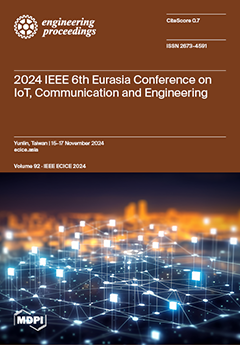Eng. Proc., 2025, IEEE ECICE 2024
2024 IEEE 6th Eurasia Conference on IoT, Communication and Engineering
Yunlin, Taiwan| 15–17 November 2024
Volume Editors:
Teen-Hang Meen, National Formosa University, Taiwan
Chi-Ting Ho, National Formosa University, Taiwan
Cheng-Fu Yang, National University of Kaohsiung, Taiwan
- Issues are regarded as officially published after their release is announced to the table of contents alert mailing list.
- You may sign up for e-mail alerts to receive table of contents of newly released issues.
- PDF is the official format for papers published in both, html and pdf forms. To view the papers in pdf format, click on the "PDF Full-text" link, and use the free Adobe Reader to open them.




